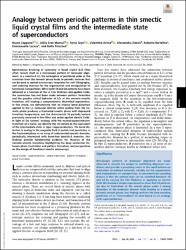| dc.contributor.author | Zappone, Bruno | |
| dc.contributor.author | Mamuk, Atilla Eren | |
| dc.contributor.author | Gryn, Iryna | |
| dc.contributor.author | Arima, Valentina | |
| dc.contributor.author | Zizzari, Alessandra | |
| dc.contributor.author | Bartolino, Roberto | |
| dc.contributor.author | Petschek, Rolfe | |
| dc.date.accessioned | 2020-11-20T14:39:22Z | |
| dc.date.available | 2020-11-20T14:39:22Z | |
| dc.date.issued | 2020 | |
| dc.identifier.issn | 0027-8424 | |
| dc.identifier.uri | https://doi.org/10.1073/pnas.2000849117 | |
| dc.identifier.uri | https://hdl.handle.net/20.500.12809/394 | |
| dc.description | Mamuk, Atilla Eren/0000-0002-1524-3342; Kasianiuk, Iryna/0000-0002-8448-5433 | en_US |
| dc.description | WOS: 000555848400008 | en_US |
| dc.description | PubMed ID: 32661146 | en_US |
| dc.description.abstract | Spontaneous breaking of symmetry in liquid crystal (LC) films often reveals itself as a microscopic pattern of molecular align-ment. In a smectic-A LC, the emergence of positional order at the transition from the nematic phase leads to periodic textures that can be used as optical microarrays, templates for soft lithography, and ordering matrices for the organization and manipulation of functional nanoparticles. While both 1d and 2d patterns have been obtained as a function of the LC film thickness and applied fields, the connection has not been made between pattern formation and the peculiar critical behavior of LCs at the nematic-smectic transition, still eluding a comprehensive theoretical explanation. In this article, we demonstrate that an intense bend distortion applied to the LC molecular director while cooling from the ne-matic phase produces a frustrated smectic phase with depressed transition temperature, and the characteristic 1d periodic texture previously observed in thin films and under applied electric fields. In light of De Gennes' analogy with the normal-superconductor transition of a metal, we identify the 1d texture as the equivalent of the intermediate state in type I superconductors. The bend dis-tortion is analog to the magnetic field in metals and penetrates in the frustrated phase as an array of undercooled nematic domains, periodically intermixed with bend-free smectic-A domains. Our findings provide fundamental evidence for theories of the nematic-smectic transition, highlighting the deep connection be-tween phase frustration and pattern formation, and perspectives on the design of functional smectic microarrays. | en_US |
| dc.description.sponsorship | Scientific and Technical Research Council of Turkey-International Doctoral Research Fellowship Programme 2214/A | en_US |
| dc.description.sponsorship | We are grateful to Charles Rosenblatt at Case Western Reserve University for his comments and suggestions. We thank Roberto Termine of Consiglio Nazionale delle Ricerche, Istituto di Nanotecnologia, for his help with the stylus profilometer. A.E.M. also acknowledges the support of the Scientific and Technical Research Council of Turkey-International Doctoral Research Fellowship Programme 2214/A. | en_US |
| dc.item-language.iso | eng | en_US |
| dc.publisher | Natl Acad Sciences | en_US |
| dc.item-rights | info:eu-repo/semantics/closedAccess | en_US |
| dc.subject | Liquid Crystals | en_US |
| dc.subject | Superconductors | en_US |
| dc.subject | Phase Transitions | en_US |
| dc.subject | Pattern Formation | en_US |
| dc.subject | Phase Frustration | en_US |
| dc.title | Analogy between periodic patterns in thin smectic liquid crystal films and the intermediate state of superconductors | en_US |
| dc.item-type | article | en_US |
| dc.contributor.department | MÜ, Fen Fakültesi, Fizik Bölümü | en_US |
| dc.contributor.institutionauthor | Mamuk, Atilla Eren | |
| dc.identifier.doi | 10.1073/pnas.2000849117 | |
| dc.identifier.volume | 117 | en_US |
| dc.identifier.issue | 30 | en_US |
| dc.identifier.startpage | 17643 | en_US |
| dc.identifier.endpage | 17649 | en_US |
| dc.relation.journal | Proceedings of the National Academy of Sciences of the United States of America | en_US |
| dc.relation.publicationcategory | Makale - Uluslararası Hakemli Dergi - Kurum Öğretim Elemanı | en_US |


















